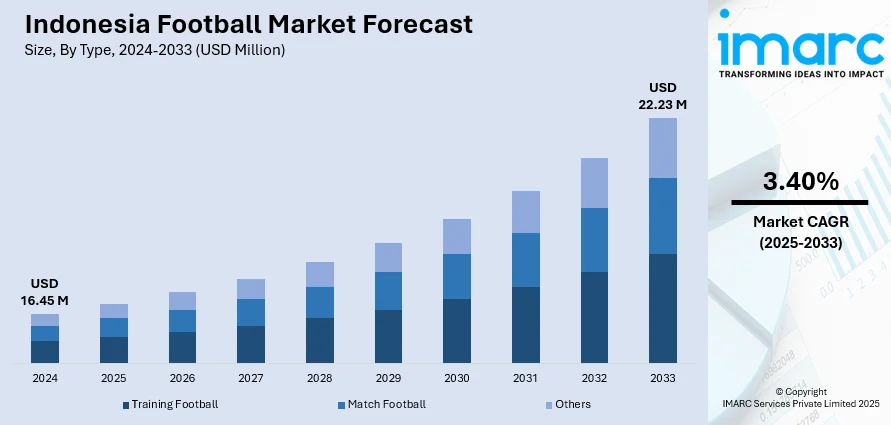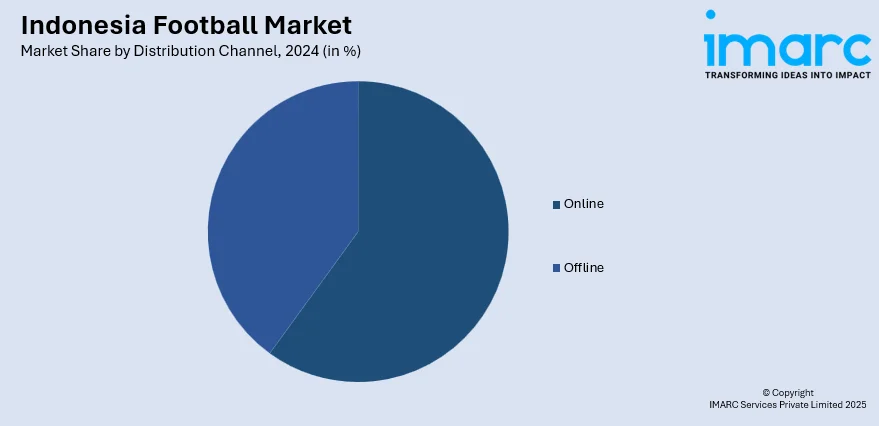
Indonesia Football Market Size, Share, Trends and Forecast by Type, Size, Distribution Channel, and Region, 2025-2033
Indonesia Football Market Overview:
The Indonesia football market size reached USD 16.45 Million in 2024. Looking forward, IMARC Group expects the market to reach USD 22.23 Million by 2033, exhibiting a growth rate (CAGR) of 3.40% during 2025-2033. The football market in Indonesia is growing because of investments in modern infrastructure and expansion of women’s football. These factors improve facilities, broaden fan engagement, and enhance competition standards, fostering long-term market sustainability and international appeal, ultimately increasing the Indonesia football market share.
|
Report Attribute
|
Key Statistics
|
|---|---|
|
Base Year
|
2024 |
|
Forecast Years
|
2025-2033
|
|
Historical Years
|
2019-2024
|
| Market Size in 2024 | USD 16.45 Million |
| Market Forecast in 2033 | USD 22.23 Million |
| Market Growth Rate 2025-2033 | 3.40% |
Indonesia Football Market Trends:
Growing Investment in Football Infrastructure
A significant factor fueling the growth of the Indonesian football market is the strategic investment in modernizing and expanding football infrastructure across the country. Renovating and building new stadiums that meet international standards is a crucial step toward enhancing the matchday experience for fans and attracting major football events. Improved stadiums not only offer better facilities for players and spectators but also open the door for higher-value sponsorships, broadcasting deals, and ticket sales. This infrastructure upgrade helps elevate the profile of domestic football leagues and makes Indonesia an attractive host for international competitions. Additionally, by aligning stadiums with international standards, the country positions itself to potentially host global tournaments, further boosting its football credibility. The broader impact of such investments not only upgrade venues but also encourage tourism and contribute to the local economy, creating a thriving football ecosystem. For example, in 2024, Indonesia announced a $175 million investment in partnership with FIFA to renovate 21 football stadiums nationwide. The plan included building the North Sumatra Main Stadium and upgrading major venues like Harapan Bangsa Stadium, aiming to meet FIFA standards and boost national football infrastructure. As these infrastructure improvements unfold, the domestic football market is benefiting from a more professional environment, which in turn attracts more fans, increases media interest, and enhances overall market value. These advancements create a foundation for sustained growth, ensuring that Indonesian football has the facilities it needs to compete at the highest level.

To get more information of this market, Request Sample
Rising Focus on Women's Football Expansion
The increasing investment by private and government sectors on the expansion of women’s football is bolstering the Indonesia football market growth. The allocation of significant financial resources toward developing women's football not only strengthens the infrastructure and quality of the sport but also broadens the appeal of football to a wider audience. By providing funding for training camps, international matches, and the preparation of teams for global competitions, these investments lay the foundation for long-term success. This support not only helps improve the competitive level of women's teams but also creates greater visibility for the sport, attracting more fans, sponsors, and media attention. Additionally, fostering growth in women's football expands the overall talent pool, creating more opportunities for athletes and further professionalizing the sport. As women's football continues to gain traction worldwide, Indonesia’s active commitment to its development positions the country to be a competitive player on the international stage, making it an attractive market for investors and broadcasters. In line with this trend, in 2024, PSSI Chair Erick Thohir reaffirmed Indonesia’s strong commitment to developing women’s football, allocating Rp36 billion for training camps, matches, and international participation. The women’s team, coached by Satoru Mochizuki, is preparing for the 2027 FIFA Women’s World Cup qualifiers.
Indonesia Football Market Segmentation:
IMARC Group provides an analysis of the key trends in each segment of the market, along with forecasts at the country and regional levels for 2025-2033. Our report has categorized the market based on type, size, and distribution channel.
Type Insights:
- Training Football
- Match Football
- Others
The report has provided a detailed breakup and analysis of the market based on the type. This includes training football, match football, and others.
Size Insights:
- Size 1
- Size 2
- Size 3
- Size 4
- Size 5
A detailed breakup and analysis of the market based on the size have also been provided in the report. This includes size 1, size 2, size 3, size 4, and size 5.
Distribution Channel Insights:

- Online
- Offline
The report has provided a detailed breakup and analysis of the market based on the distribution channel. This includes online and offline.
Regional Insights:
- Java
- Sumatra
- Kalimantan
- Sulawesi
- Others
The report has also provided a comprehensive analysis of all the major regional markets, which include Java, Sumatra, Kalimantan, Sulawesi, and others.
Competitive Landscape:
The market research report has also provided a comprehensive analysis of the competitive landscape. Competitive analysis such as market structure, key player positioning, top winning strategies, competitive dashboard, and company evaluation quadrant has been covered in the report. Also, detailed profiles of all major companies have been provided.
Indonesia Football Market News:
- In December 2024, Indonesia made history by winning their first-ever AFF Women’s Cup, defeating Cambodia 3-1 in the final. Reva Octaviani was named Player of the Tournament, while Laita Masykuroh earned the Golden Glove. Coach Satoru Mochizuki aimed to build on this success toward future Asian and World Cup goals.
- In November 2024, Indonesian national team coach Shin Tae-yong launched the STY Foundation to support youth football development in Indonesia. The foundation, backed by Raffi Ahmad, aimed to improve infrastructure, create football academies, and run junior leagues.
Indonesia Football Market Report Coverage:
| Report Features | Details |
|---|---|
| Base Year of the Analysis | 2024 |
| Historical Period | 2019-2024 |
| Forecast Period | 2025-2033 |
| Units | Million USD |
| Scope of the Report |
Exploration of Historical Trends and Market Outlook, Industry Catalysts and Challenges, Segment-Wise Historical and Future Market Assessment:
|
| Types Covered | Training Football, Match Football, Others |
| Sizes Covered | Size1, Size 2, Size 3, Size 4, Size 5 |
| Distribution Channels Covered | Online, Offline |
| Regions Covered | Java, Sumatra, Kalimantan, Sulawesi, Others |
| Customization Scope | 10% Free Customization |
| Post-Sale Analyst Support | 10-12 Weeks |
| Delivery Format | PDF and Excel through Email (We can also provide the editable version of the report in PPT/Word format on special request) |
Key Questions Answered in This Report:
- How has the Indonesia football market performed so far and how will it perform in the coming years?
- What is the breakup of the Indonesia football market on the basis of type?
- What is the breakup of the Indonesia football market on the basis of size?
- What is the breakup of the Indonesia football market on the basis of distribution channel?
- What is the breakup of the Indonesia football market on the basis of region?
- What are the various stages in the value chain of the Indonesia football market?
- What are the key driving factors and challenges in the Indonesia football market?
- What is the structure of the Indonesia football market and who are the key players?
- What is the degree of competition in the Indonesia football market?
Key Benefits for Stakeholders:
- IMARC’s industry report offers a comprehensive quantitative analysis of various market segments, historical and current market trends, market forecasts, and dynamics of the Indonesia football market from 2019-2033.
- The research report provides the latest information on the market drivers, challenges, and opportunities in the Indonesia football market.
- Porter's five forces analysis assist stakeholders in assessing the impact of new entrants, competitive rivalry, supplier power, buyer power, and the threat of substitution. It helps stakeholders to analyze the level of competition within the Indonesia football industry and its attractiveness.
- Competitive landscape allows stakeholders to understand their competitive environment and provides an insight into the current positions of key players in the market.
Need more help?
- Speak to our experienced analysts for insights on the current market scenarios.
- Include additional segments and countries to customize the report as per your requirement.
- Gain an unparalleled competitive advantage in your domain by understanding how to utilize the report and positively impacting your operations and revenue.
- For further assistance, please connect with our analysts.
 Request Customization
Request Customization
 Speak to an Analyst
Speak to an Analyst
 Request Brochure
Request Brochure
 Inquire Before Buying
Inquire Before Buying




.webp)




.webp)












